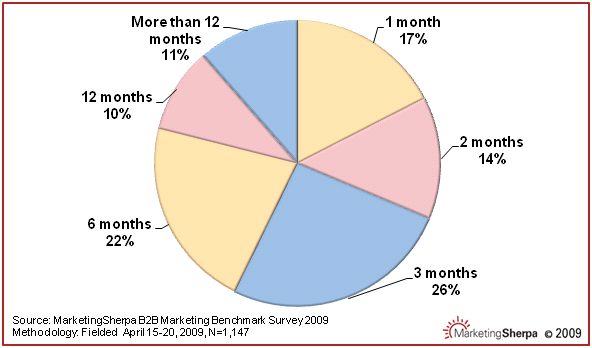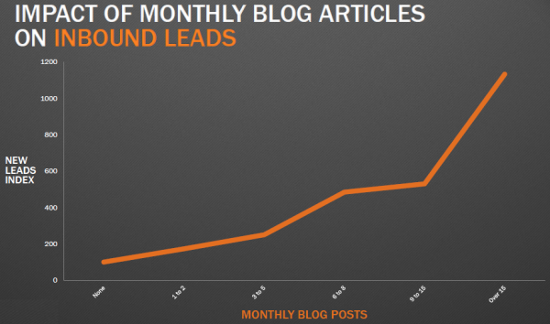 Marketing ROI isn’t a myth like some kind of marketing unicorn – but business owners and marketers can set themselves up to know what to expect.
Marketing ROI isn’t a myth like some kind of marketing unicorn – but business owners and marketers can set themselves up to know what to expect.
Otherwise, waiting for marketing to pay off can be a recipe for frustration.
Many factors impact speed to business results. Some factors are in our control, others aren't.
Here's a look at the most significant variables that impact your marketing ROI timeline, with a few suggestions to get results faster.
1. The length of your sales cycle
According to a Marketing Sherpa study of B2B marketers, it takes from one month to a year (or more) to nurture new prospects through the sales funnel, as shown below.
Timing depends on industry and other factors:

Is it possible to speed up your sales cycle? It is. Having the right lead generation and nurturing strategy is key, especially for highly considered buying decisions.
It's a two-step process: align both your content and your sales process to buyer stages in order to generate more sales-ready leads at the top of the funnel. And, combine the right content with lead nurturing and social selling tactics to move prospects through the sales funnel faster.
2. Building the right marketing foundation
Often marketers expect "if we build it they will come." This is not a strategy for growth. For any new marketing program to yield results, we need to uncover the root causes for business under-performance.It's easy to underestimate the time needed to quantify these elements in order to build the right performance plan.
Can you fast track this? Yes, you can. Your existing marketing programs can function as research; then, you can be prepared to solve specific problems that the data reveal.
For starters, have the right infrastructure in place to look at the data. Where are new customers coming from? How is your website working to deliver new prospects? Where do your marketing tools work; and where does the process stall?
Quantitative tools can include:
- Google Analytics to understand site traffic sources, your highest performing website pages, where traffic drop-off suggests opportunity for better engagement
- Tracking the journey of customers through your site and other marketing tactics – what works best to lead a prospect to customer status? Don't guess.
- Search engine optimization is more than keywords. Ask yourself: how does website content contribute to traffic and visitor engagement. Is there a place on your site where you continue to place dynamic, traffic-generating content (hint: blog pages)?
Some “pay to play” marketing tactics – PPC or other forms of paid advertising, for instance – can also serve as research tools to better understand search terms and content success. They are easy to turn on and off and can provide quantitative direction over a short period of time. Then, these results can be deployed through organic traffic engines (blog posts, social media messaging) for more cost effective success.
In this way, a balance of short and longer-term tactics can be used to kick start results.
3. Marketing budget needed to achieve visibility
Some marketing assets take longer to build.
Take blogging, for instance. The relationship between blogging and lead generation is well established. The more quality content you publish, the faster new leads can be added to your sales funnel for nurturing, and the sooner you’ll see results.
According to the 2015 B2B Web Usability Report, however, it takes 10.4 pieces of content (on average) before a prospect will initiate some form of engagement or buying opportunity. So the key question is, are you creating enough quality content? And, are your prospects seeing it?

(Source: Hubspot)
Can you accelerate online visibility? The rate of marketing plan execution -- and visibility achieved -- often depends on marketing investment. An ambitious marketing budget, according to the 2015 CMO Survey, is roughly eight percent of company revenue.
If you grow tired of waiting for results despite the right mix of activities, you may want to re-evaluate your investment parameters.
Marketing ROI: “Rome wasn’t built in a day”
Last week, we looked at the typical delay between beginning a new integrated market program, and achieving marketing ROI.
Today we saw how long it takes for specific marketing tactics to work, and which are within our control to accelerate.
The prescription for business owners: recalibrate expectations regarding how long marketing takes to work, set aside ample resources to manage it, and stay the course.But for those who persevere, as shown in our case studies, the results can be rewarding.
Contact us for a Whiteboard Consultation, for a road map to better -- and faster -- marketing results for your business.






